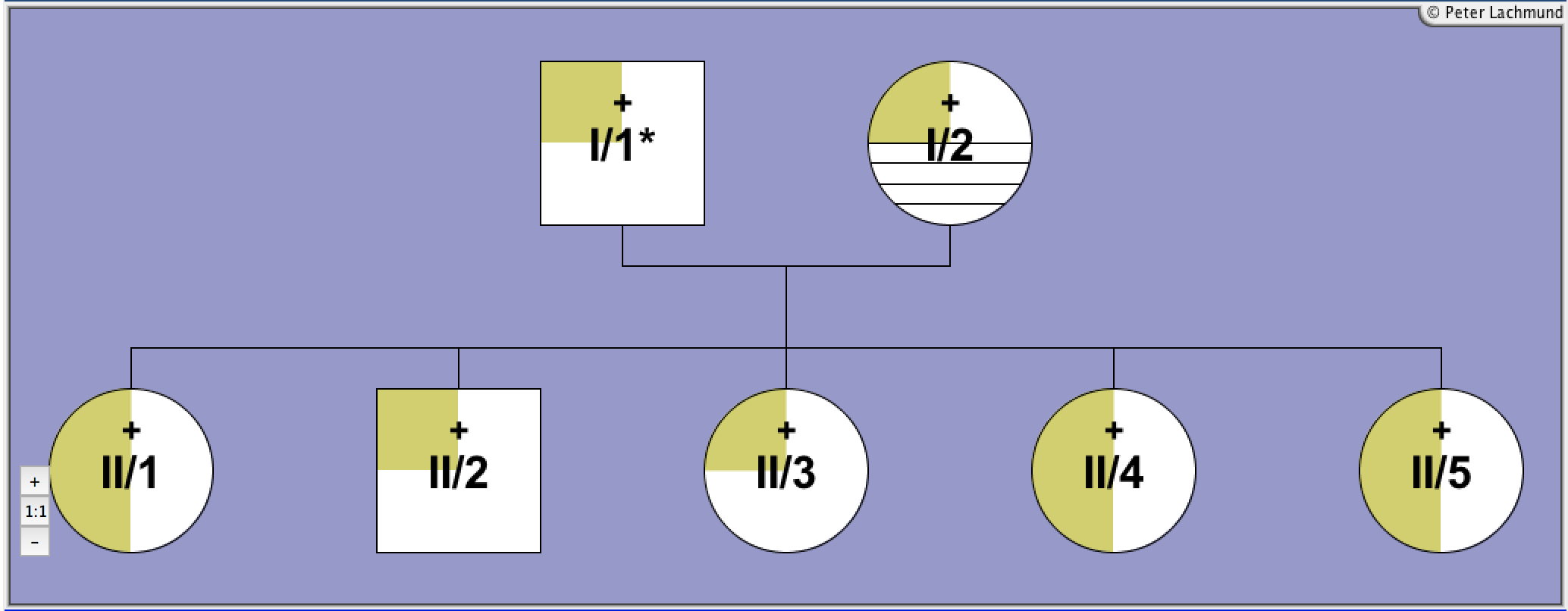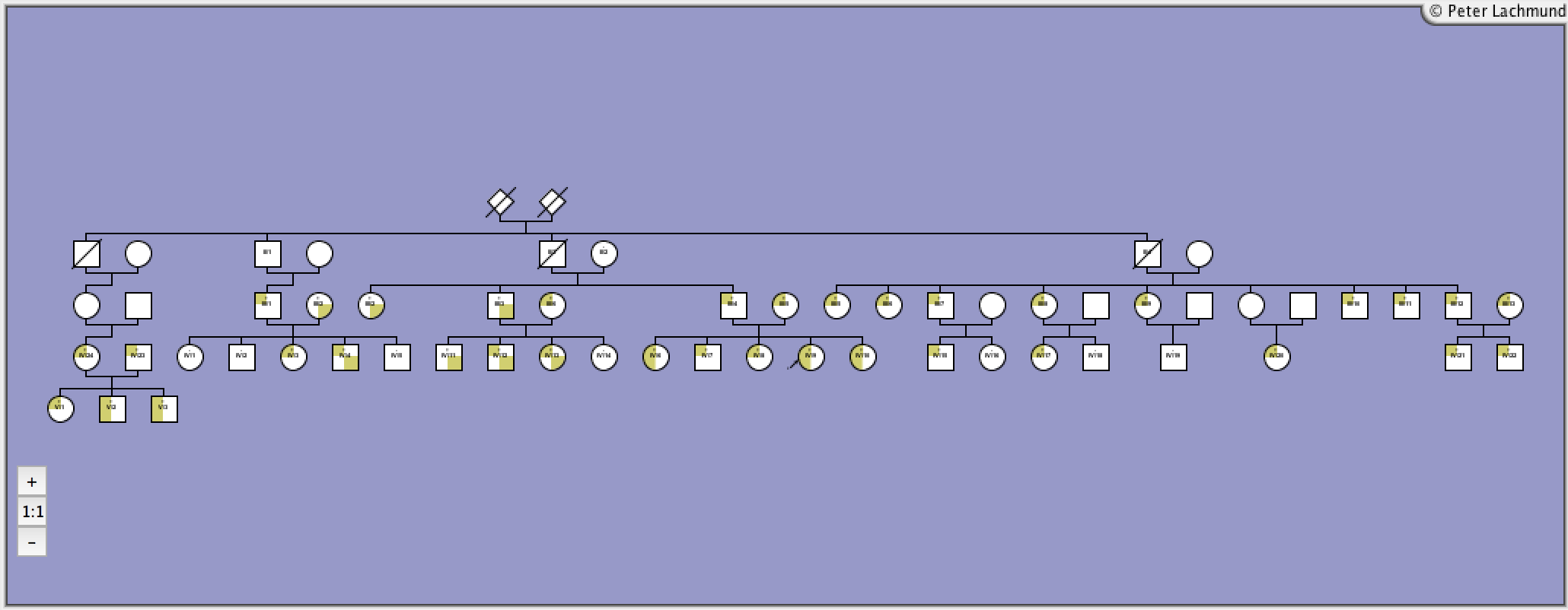Details Of Published TSH Receptor Mutation
Leu 653 Val
c.1957C>gInactivating TSH Receptor Mutation
Type
loss
Manifestation
family
Exon
10
Legend:

Male

Female

Unknown

Deceased
+
Mutation
-
Wild-Type

Heterozygous

Heterozygous

Compound Heterozygous

Homozygous

Hypothyroid

Hypoplastic Gland + Hypothyroid
P
Index Patient
Molecular Characteristics:
Family 1 - pedigree 1 (Grasberger et al.):
I/1* and I/2* first cousins (F = 0.125)
II/1,4,5 homozygous
I/1,I/2,II/2,3 heterozygous
Family 2 - pedigree 2 (Tenenbaum et al.):
IV/6, IV/9 (proposita), IV/10, V/2, V/3: L635V/L635V
III/2, III/3, III/13, IV/11: P68S/wt
IV/4, IV/12, IV/13, IV/22: P68S/L635V compound heterozygous
20 individuals: L635V/wt
3 further individuals: L635V/wt, 1 patient with P68S/wt (detected by population screening)
genotype screening in local population: L635V/wt one individual
P68S/wt: 2 individuals
I/1* and I/2* first cousins (F = 0.125)
II/1,4,5 homozygous
I/1,I/2,II/2,3 heterozygous
Family 2 - pedigree 2 (Tenenbaum et al.):
IV/6, IV/9 (proposita), IV/10, V/2, V/3: L635V/L635V
III/2, III/3, III/13, IV/11: P68S/wt
IV/4, IV/12, IV/13, IV/22: P68S/L635V compound heterozygous
20 individuals: L635V/wt
3 further individuals: L635V/wt, 1 patient with P68S/wt (detected by population screening)
genotype screening in local population: L635V/wt one individual
P68S/wt: 2 individuals
Clinical Features:
Family 1 - pedigree 1 (Grasberger et al.):
II/4: 10.5yr (proposita), sinus tachycardia, euthyroid hyperthyrotopiniaemia, TPO Ab negative, Thyroid normal size, eutopic, increased uptake
II/5: 6.5yr sister, euthyroid hyperthyrotropinaemia
II/1: 22yr sister: euthyroid hyperthyrotropinaemia
II/5 and II/1: no symptoms of hypothyroidism
parents other siblings (girl II/3, boy II/2): no symptoms of hypothyroidism
Family 2 - pedigree 2 (Tenenbaum et al.):
IV/9: proposita: 10yr, sinus tachycardia (TSH elevated, T4 and T3 normal)
IV/6, IV/10: two sisters: (TSH elevated, T4 and T3 normal)
IV/6: autoimmune thyroid disease
II/4: 10.5yr (proposita), sinus tachycardia, euthyroid hyperthyrotopiniaemia, TPO Ab negative, Thyroid normal size, eutopic, increased uptake
II/5: 6.5yr sister, euthyroid hyperthyrotropinaemia
II/1: 22yr sister: euthyroid hyperthyrotropinaemia
II/5 and II/1: no symptoms of hypothyroidism
parents other siblings (girl II/3, boy II/2): no symptoms of hypothyroidism
Family 2 - pedigree 2 (Tenenbaum et al.):
IV/9: proposita: 10yr, sinus tachycardia (TSH elevated, T4 and T3 normal)
IV/6, IV/10: two sisters: (TSH elevated, T4 and T3 normal)
IV/6: autoimmune thyroid disease
Treatment:
no data
Functional Characteristics:
cAMP
(basal)
(basal)
cAMP
(TSH)
(TSH)
IP
(basal)
(basal)
IP
(TSH)
(TSH)
TSH-Binding
Cell Surface Expression
Prevalence
LRA
Ref
2
Legend:
cAMP (basal): basal in vitro cAMP production of mutant over wild-type TSHR
cAMP (TSH): maximal in vitro cAMP production of mutant over wild-type TSHR
IP (basal): basal in vitro IP production of mutant over wild-type TSHR
IP (TSH): maximal in vitro IP production of mutant over wild-type TSHR
TSH-binding: maximal TSH-binding compared to the wild-type TSHR
Cell surface expression: cell surface expression of mutant compared to WT-TSHR
LRA: linear regression analysis (LRA) of constitutive activity as a function of TSHR expression determined by 125I-bTSH binding or FACS analysis compared to the wild-type TSHR
Prevalence: Prevalence of (somatic and germline) activating mutations*
Ref: Reference for functional characterization
Child: Found in children.


